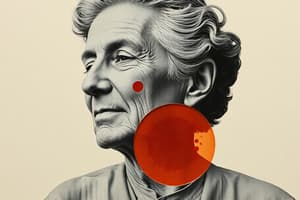Podcast
Questions and Answers
Why is determining why a fall occurred important?
Why is determining why a fall occurred important?
- To assign blame for the fall
- To prevent future falls (correct)
- To justify medical expenses
- To ensure proper documentation
Which of the following is not a condition considered as intrinsic fall risk factors for elders?
Which of the following is not a condition considered as intrinsic fall risk factors for elders?
- Fear of falling
- Urinary incontinence (correct)
- Osteoporosis
- Chronic pain
What is a common post-fall assessment instrument used in acute and long-term care settings?
What is a common post-fall assessment instrument used in acute and long-term care settings?
- Hendrich II Scale
- Morse Fall Scale (correct)
- STEDI
- Symptom Severity Scale
Which of the following is an extrinsic fall risk factor for elders?
Which of the following is an extrinsic fall risk factor for elders?
When should a postfall assessment be conducted according to the text?
When should a postfall assessment be conducted according to the text?
Which of the following is NOT a risk factor for falls in elders?
Which of the following is NOT a risk factor for falls in elders?
A patient with orthostatic hypotension is at increased risk of falls due to which of the following?
A patient with orthostatic hypotension is at increased risk of falls due to which of the following?
Which of the following cognitive impairments is LEAST likely to increase fall risk in elders?
Which of the following cognitive impairments is LEAST likely to increase fall risk in elders?
A patient with bunions and hammertoes is at increased risk of falls due to which of the following?
A patient with bunions and hammertoes is at increased risk of falls due to which of the following?
Which of the following vision problems is MOST likely to increase fall risk in elders?
Which of the following vision problems is MOST likely to increase fall risk in elders?
What tool is used to determine a safe exercise program for older adults based on their underlying physical conditions?
What tool is used to determine a safe exercise program for older adults based on their underlying physical conditions?
Which model includes the Get-Up-and-Go test for assessing mobility, gait, and gait speed?
Which model includes the Get-Up-and-Go test for assessing mobility, gait, and gait speed?
What should nurses be knowledgeable about in terms of promoting healthy aging interventions?
What should nurses be knowledgeable about in terms of promoting healthy aging interventions?
Which of the following is presented in Box 18.4 for adults 65 years and older who are generally fit?
Which of the following is presented in Box 18.4 for adults 65 years and older who are generally fit?
What is emphasized as important in the context of promoting healthy aging interventions?
What is emphasized as important in the context of promoting healthy aging interventions?
What is the leading cause of both fatal and nonfatal injuries among people older than 65 years?
What is the leading cause of both fatal and nonfatal injuries among people older than 65 years?
Which of the following is NOT one of the seven types of fall classifications mentioned in the text?
Which of the following is NOT one of the seven types of fall classifications mentioned in the text?
Which of the following is the most important risk factor for future falls among older adults?
Which of the following is the most important risk factor for future falls among older adults?
What percentage of hip fractures are caused by falls in older adults?
What percentage of hip fractures are caused by falls in older adults?
Which of the following is NOT a key factor in maintaining function for hospitalized older adults?
Which of the following is NOT a key factor in maintaining function for hospitalized older adults?
Older adults who experience significant loss of total, lean, and fat mass strength during hospitalization are at greater risk for which of the following?
Older adults who experience significant loss of total, lean, and fat mass strength during hospitalization are at greater risk for which of the following?
Which of the following interventions has been shown to have positive effects for maintaining function in long-term care settings?
Which of the following interventions has been shown to have positive effects for maintaining function in long-term care settings?
Which of the following is a key tip for function-focused care in acute care settings?
Which of the following is a key tip for function-focused care in acute care settings?
Which of the following is a risk factor for falls in older adults that should be addressed in acute care settings?
Which of the following is a risk factor for falls in older adults that should be addressed in acute care settings?
Which of the following is NOT a typical age-related change that can contribute to mobility issues in older adults?
Which of the following is NOT a typical age-related change that can contribute to mobility issues in older adults?
An older adult with cognitive impairment would likely benefit most from which type of exercise recommendation?
An older adult with cognitive impairment would likely benefit most from which type of exercise recommendation?
Which of the following is a key risk factor for falls in older adults that is related to vision and hearing changes?
Which of the following is a key risk factor for falls in older adults that is related to vision and hearing changes?
Which of the following is the LEAST important factor to assess when evaluating an older adult's fall risk?
Which of the following is the LEAST important factor to assess when evaluating an older adult's fall risk?
An older adult experiences a sudden drop in blood pressure when standing up, a condition known as orthostatic hypotension. Which of the following is the MOST important step to take to help reduce their fall risk?
An older adult experiences a sudden drop in blood pressure when standing up, a condition known as orthostatic hypotension. Which of the following is the MOST important step to take to help reduce their fall risk?
Which of the following is NOT a common risk factor for falls in older adults?
Which of the following is NOT a common risk factor for falls in older adults?
Which of the following is a potential consequence of orthostatic hypotension in older adults?
Which of the following is a potential consequence of orthostatic hypotension in older adults?
Which of the following is a common gait disturbance in older adults?
Which of the following is a common gait disturbance in older adults?
Which of the following is NOT a common foot disturbance in older adults?
Which of the following is NOT a common foot disturbance in older adults?
Which of the following is a potential consequence of cognitive impairment in older adults?
Which of the following is a potential consequence of cognitive impairment in older adults?
Which of the following is NOT a common vision problem in older adults?
Which of the following is NOT a common vision problem in older adults?
Which of the following is a potential consequence of hearing loss in older adults?
Which of the following is a potential consequence of hearing loss in older adults?
Which of the following is a common foot deformity in older adults?
Which of the following is a common foot deformity in older adults?
Which of the following is a potential risk factor for falls in older adults with cognitive impairment?
Which of the following is a potential risk factor for falls in older adults with cognitive impairment?
Which of the following is a potential consequence of foot deformities in older adults?
Which of the following is a potential consequence of foot deformities in older adults?
Flashcards are hidden until you start studying
Study Notes
- Falls among older adults are a significant concern, with risk factors including chronic conditions, medication use, fear of falling, and environmental hazards.
- Fall risk assessments are crucial in primary health care and acute/long-term care settings, utilizing tools like STEADI, Morse Fall Scale, and Hendrich II Scale.
- Post-fall assessments are essential to determine the cause of falls and should include incident reporting and documentation.
- Interventions to reduce fall risk include vision screening, medication management, hip protectors, education, and environmental modifications.
- Restraint-free care is becoming a standard practice in healthcare, with a focus on alternative strategies to restraints for patient safety.
- Mobility screening tools like the Hendrich II Fall Risk Model can assess mobility, gait, and speed to prevent falls among older adults.
- Physical activity is crucial for healthy aging, with guidelines provided for exercise programs and incorporating physical activity into daily routines for older adults.
Studying That Suits You
Use AI to generate personalized quizzes and flashcards to suit your learning preferences.




